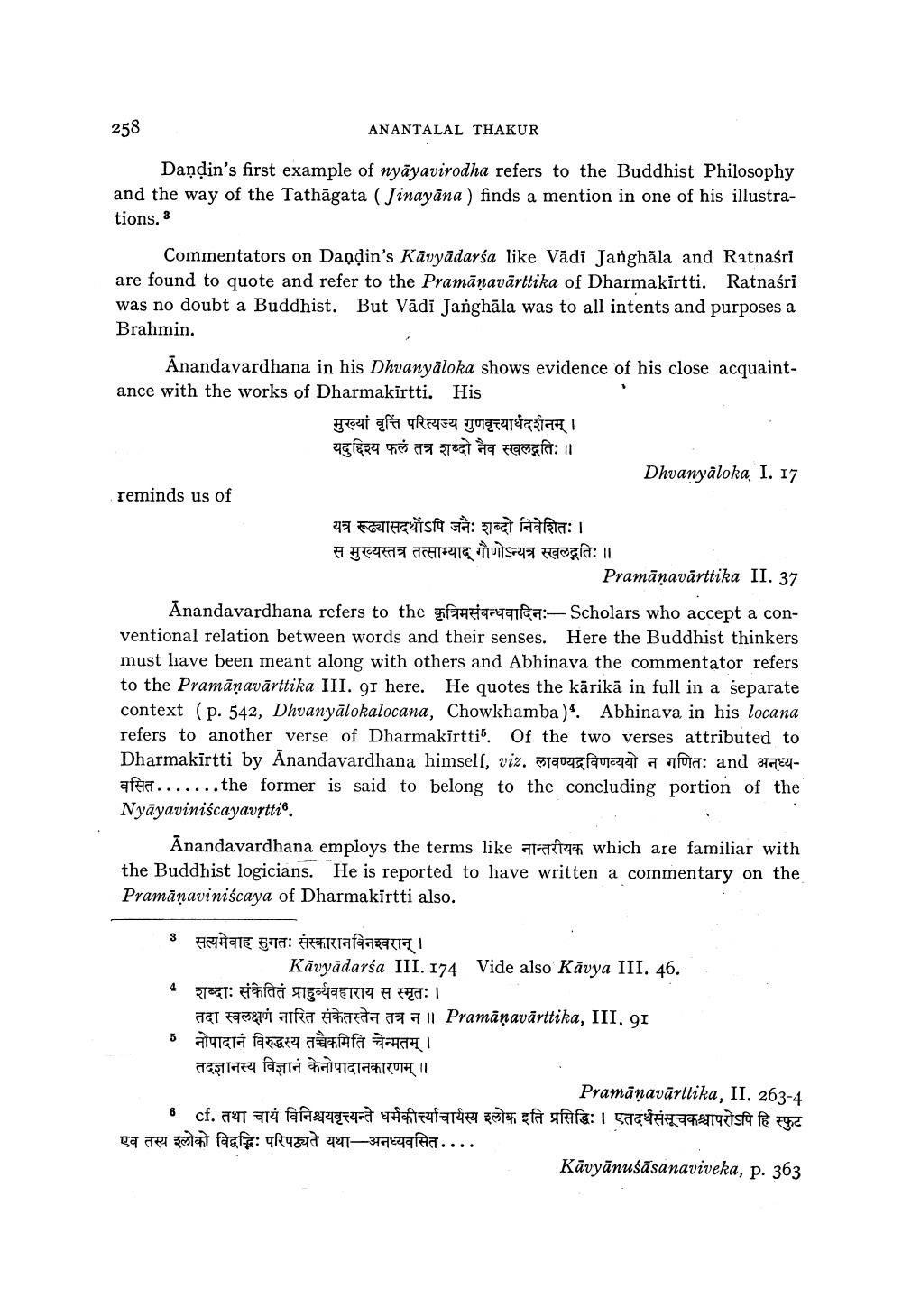________________
258
ANANTALAL THAKUR
Dandin's first example of nyāyavirodha refers to the Buddhist Philosophy and the way of the Tathāgata ( Jinayāna) finds a mention in one of his illustrations. 3
Commentators on Dandin's Kāvyādarśa like Vädi Janghāla and Ratnasri are found to quote and refer to the Pramāņavārttika of Dharmakirtti. Ratnaśri was no doubt a Buddhist. But Vādi Janghāla was to all intents and purposes a Brahmin.
Anandavardhana in his Dhvanyaloka shows evidence of his close acquaintance with the works of Dharmakirtti. His
मुख्यां वृत्तिं परित्यज्य गुणवृत्त्यार्थदर्शनम् । यदुद्दिश्य फलं तत्र शब्दो नैव स्खलद्गतिः ॥
Dhvanyaloka I. 17 reminds us of
यत्र रूढ्यासदर्थोऽपि जनैः शब्दो निवेशितः । स मुख्यस्तत्र तत्साम्याद् गौणोऽन्यत्र स्खलद्गतिः ॥
Pramāņavārttika II. 37 Anandavardhana refers to the कृत्रिमसंबन्धवादिनः-Scholars who accept a conventional relation between words and their senses. Here the Buddhist thinkers must have been meant along with others and Abhinava the commentator refers to the Pramāņavārttika III. 91 here. He quotes the kārikā in full in a separate context (p. 542, Dhvanyālokalocana, Chowkhamba)". Abhinava. in his locana refers to another verse of Dharmakīrtti5. Of the two verses attributed to Dharmakirtti by Anandavardhana himself, viz. लावण्यद्रविणव्ययो न गणितः and अनध्यवसित .......the former is said to belong to the concluding portion of the Nyāyaviniscayavytti6.
Anandavardhana employs the terms like alten which are familiar with the Buddhist logicians. He is reported to have written a commentary on the Pramāņaviniscaya of Dharmakirtti also.
३ सत्यमेवाह सुगतः संस्कारानविनश्वरान् ।
Kávyādarśa III. 174 Vide also Kāvya III. 46. - शब्दाः संकेतितं प्राहुर्व्यवहाराय स स्मृतः ।
तदा स्वलक्षणं नास्ति संकेतस्तेन तत्र न ॥ Pramānavarttika, III. 91 नोपादानं विरुद्धरय तच्चैकमिति चेन्मतम् । तदज्ञानस्य विज्ञानं केनोपादानकारणम् ।
Pramāņavārttika, II. 263-4 6 cf. तथा चायं विनिश्चयवृत्त्यन्ते धर्मकीर्त्याचार्यस्य श्लोक इति प्रसिद्धिः । एतदर्थसंसूचकश्चापरोऽपि हि स्फुट एव तस्य इलोको विद्वद्भिः परिपठ्यते यथा-अनध्यवसित....
Kāvyānusāsanaviveka, p. 363




